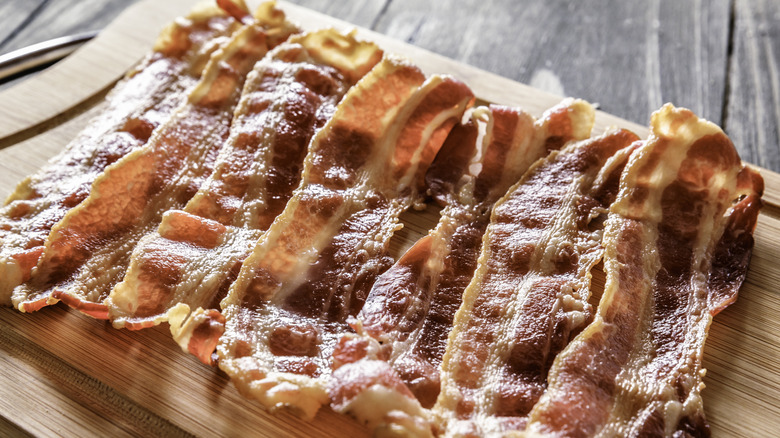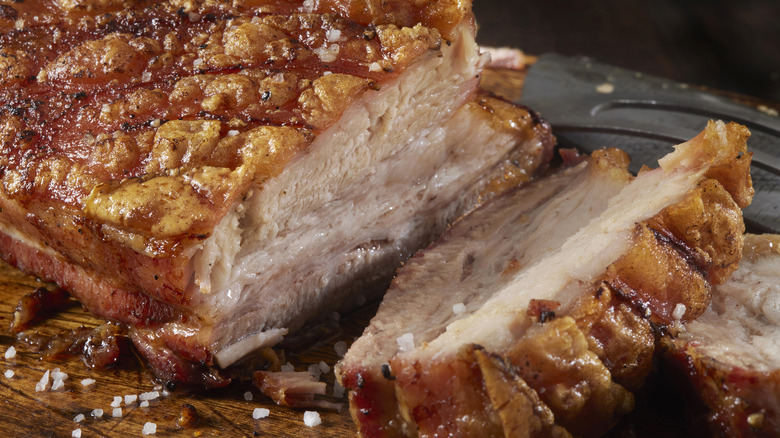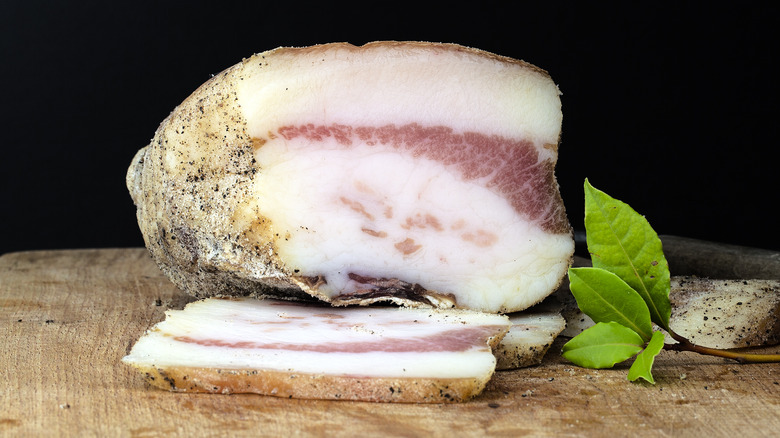Is Bacon The Same Thing As Pork Belly?
Bacon is usually made from pork belly, but are the two products interchangeable? Just try swapping these ingredients when making pork belly bao buns and you'll see how different they are. While they might come from the same source, they each have unique qualities and applications.
One clear divide is that pork belly is sold fresh and uncured; bacon, on the other hand, is commonly processed via curing and smoking over apple or hickory wood. This means that bacon has been treated with ingredients like sugar, salt, and nitrates to give it its trademark flavor. Pork belly is untreated, so it won't have the smokey taste of bacon. Instead, it will offer a buttery, pleasantly fatty flavor.
The two items are also commonly packaged differently. While bacon can be sold in whole slabs, it's usually found pre-sliced in strips. Pork belly comes in many forms, from entire roasts of meat to thin-cut pieces. A whole piece will commonly have a thick fat cap with skin affixed to the top. Bacon also carries a higher price tag due to the extra time and labor the smoking and curing processes require.
The different ways to use bacon and pork belly
These two meats are also distinct in that they have different purposes in the kitchen. Whereas bacon often accompanies a larger dish (such as a breakfast side or in a BLT), pork belly tends to take center stage as a main protein at mealtime. It's suited to slow cooking techniques, which sets it apart from the more quick-cooking bacon. Making slow-roasted pork belly is an easy and delicious way to prepare the meat. Start by scoring the skin so the fat can render better. After a long time in the oven, it will crisp up into a delicious crust.
Pork belly is also well suited to braising in flavorful liquids. Chashu, the tender pork used to top many styles of ramen, is made by simmering whole pork belly with ingredients like soy sauce, mirin, and sugar. Unlike bacon, recipes such as Chinese red braised pork belly call for the meat to be blanched before cooking, which removes aesthetic impurities that can leach out into the cooking liquid.
This cut can also be used in quick cooking applications like Korean barbecue, where it's sliced thin and cooked over fire. Even in this scenario, it will still take longer to fully cook pork belly than it will to crisp up bacon. Finally, bacon can be sliced into lardons and used to flavor other dishes like shrimp or Cajun corn chowder. Because pork belly does not carry the inherent smoky quality of bacon, it can't be used in the same way.
Bacon compared to other styles of cured pork belly
Bacon is far from the only pork product that gets smoked or cured. Italian pancetta, for example, is also made from pork belly. Whereas bacon is smoked, however, pancetta is not. The latter is also rubbed with extra spices such as juniper berries and nutmeg during the curing process. These ingredients — coupled with the lack of smoking — give pancetta a brighter, cleaner flavor. Use it to make Roman pasta dishes like spaghetti alla carbonara or to complete a charcuterie board. Guanciale is a similar style of cured Italian pork, although it's cut from the jowl and contains more spices. Bacon can be substituted for either of these meats, but it will change the nature of a dish and add a smokier flavor.
Salt pork, another product made from the belly of a pig, comes closer to bacon. As the name suggests, it gets cured with a heavy amount of salt before being smoked. It's usually purchased as a small slab and diced before cooking. Unlike bacon or pancetta, salt pork is rarely eaten on its own. Instead, it's commonly used to add fat and flavor to dishes like New England clam chowder or southern collard greens. Salt pork is a closer substitute to bacon than pancetta; that said, it doesn't contain the nitrates that bacon has, which means that it will still subtly change the flavor of your cooking.



